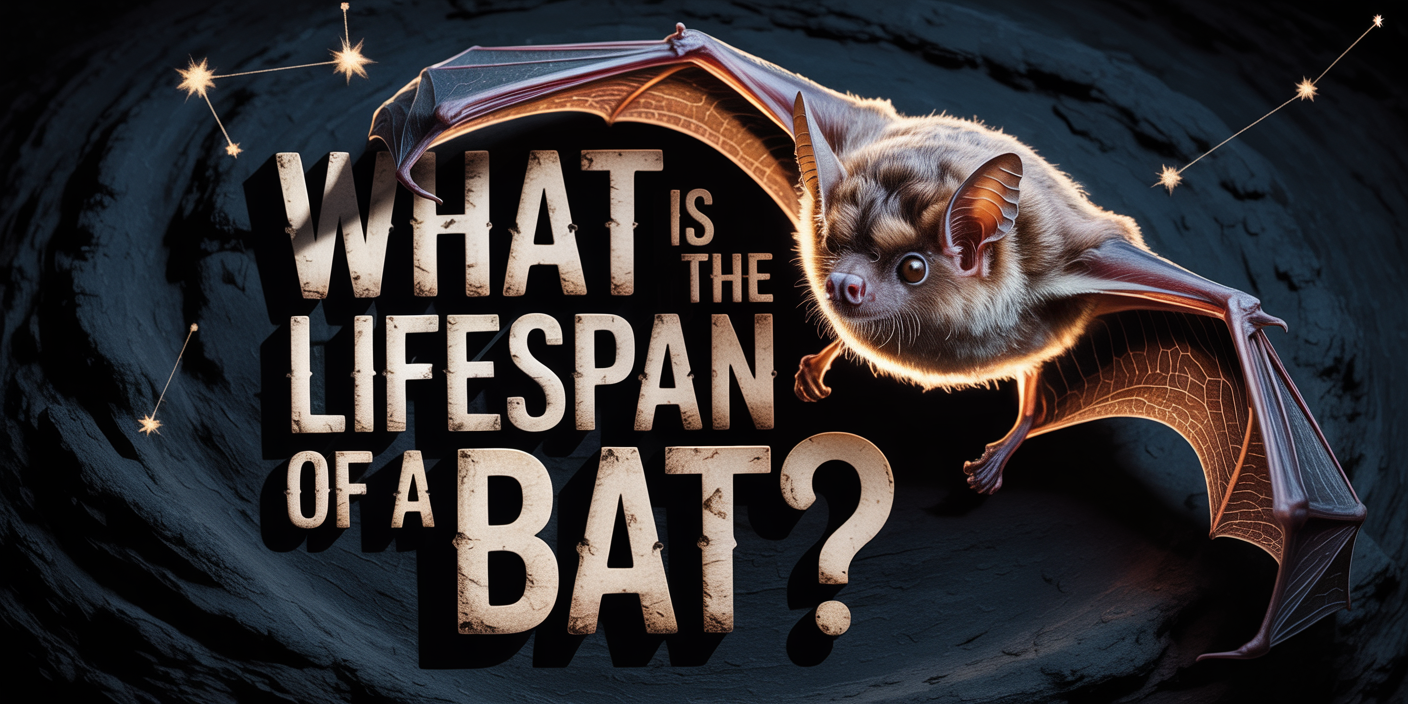The lifespan of a bat varies depending on the species, with most bats living between 10 to 30 years. Smaller species generally have shorter lifespans, while larger species can live longer, with some even reaching over 30 years in the wild.
Bats are fascinating creatures that play a crucial role in ecosystems worldwide, from controlling insect populations to aiding in pollination. One intriguing aspect of their biology is their lifespan, which can vary significantly across species. Understanding how long bats live and the factors that influence their longevity helps us appreciate these creatures even more, especially as many species face threats in the wild.
What is the average lifespan of a bat?
The average lifespan of a bat typically ranges from 10 to 30 years, though this can vary widely depending on the species and environmental conditions. Smaller bat species, such as the pipistrelle bat, tend to live shorter lives, often averaging around 6 to 10 years. In contrast, larger species, like the big brown bat, can live up to 30 years or more, making them some of the longest-living small mammals. These differences in lifespan are largely influenced by factors such as size, metabolic rate, and natural predators.
Bats’ ability to live longer than many other small mammals is also linked to their unique biology and lifestyle. Their slow metabolism, particularly during hibernation, helps them conserve energy, contributing to their longevity. Additionally, their ability to live in diverse environments—from caves to urban settings—also plays a role in determining how long they can survive. While bats face numerous threats, their remarkable ability to adapt to different habitats is one of the reasons they can live such long lives.
How long do common bat species live?
The lifespan of common bat species can vary significantly. For example, the Little Brown Bat, one of the most widely known species in North America, can live for up to 30 years under ideal conditions, though the average lifespan is closer to 6 to 10 years due to natural risks like disease and predation. Similarly, the Big Brown Bat, another common species, can live for around 19 years on average, with some individuals reaching the age of 30 in the wild. The wide range of lifespans in these species highlights the influence of environmental factors, genetics, and human-related threats.
Other bat species, like the Mexican Free-Tailed Bat, typically live shorter lives of around 10 to 15 years. The variability in lifespan is often linked to factors such as habitat, availability of food, and exposure to dangers like white-nose syndrome, a fungal disease that has had devastating effects on bat populations. While larger bat species generally enjoy longer lives, smaller species tend to have shorter, more fragile lifespans. Understanding these differences is essential for conservation efforts aimed at protecting bats, especially those facing significant environmental pressures.
Why do bats live so long compared to other small mammals?
Bats are known to live significantly longer than most small mammals, and researchers believe this is largely due to their unique biology. One of the key factors contributing to their longevity is their ability to enter a state of hibernation. During hibernation, bats significantly lower their metabolic rate, allowing them to survive for months on minimal energy. This energy conservation not only helps them endure harsh winters but also reduces wear and tear on their bodies, ultimately contributing to their long lifespans.
Additionally, bats have relatively low rates of aging compared to other mammals. Studies have shown that bats exhibit remarkable cellular regeneration, which may be linked to their longevity. Unlike other small mammals, which tend to age more rapidly, bats’ slower metabolism and ability to recover from physical stressors allow them to live longer, healthier lives. This unique combination of biological traits makes bats fascinating examples of long-lived small mammals and highlights the importance of understanding their natural history in conservation efforts.
Do bats age differently from other mammals?
Bats age in ways that are quite distinct from other small mammals, particularly in terms of their health and longevity. Unlike many mammals that experience rapid aging and deterioration, bats seem to retain their health for much longer. One reason for this is their ability to hibernate, which allows them to rest and recover, essentially “resetting” their body’s processes during the colder months. This period of dormancy not only helps conserve energy but also slows the aging process by giving bats an extended period of recovery and regeneration.
Another unique feature of bat aging is their ability to maintain relatively high levels of physical function as they age. While other mammals, like rodents, often experience significant decline in muscle mass, immune function, and overall vitality, bats tend to retain more of their youthful characteristics for longer. This is due in part to their metabolic rate, which remains relatively stable throughout their lives, and their high degree of cellular repair and regeneration. These factors contribute to bats’ ability to live long lives compared to other mammals of similar size.
What factors can shorten the lifespan of a bat?
While bats have the potential for long lifespans, several factors can significantly shorten their lives. One of the most notable threats to bat longevity is disease, particularly white-nose syndrome, a fungal infection that has devastated bat populations in North America. This disease affects bats during hibernation, disrupting their ability to conserve energy and ultimately leading to premature death. Other diseases, such as rabies or parasitic infections, can also weaken bats and reduce their lifespan. The spread of these diseases, often exacerbated by environmental changes and human activity, remains a major concern for bat conservation.
In addition to disease, environmental factors such as habitat loss and climate change pose significant risks to bat populations. The destruction of roosting sites, like caves and trees, leaves bats with fewer places to shelter, which can lead to increased vulnerability to predators, extreme temperatures, and stress. Habitat fragmentation caused by human development further isolates bat colonies, making it harder for them to find food, reproduce, and thrive. These environmental pressures, along with human-related disturbances like pesticide use and urban expansion, contribute to the shortened lifespans of bats, threatening their survival in the wild.
Can bats live in captivity for longer than in the wild?
Bats in captivity generally do not live as long as those in the wild, despite the controlled environment and regular access to food and medical care. While captivity can provide safety from predators and disease, it often lacks the natural conditions that bats need for proper physical and mental health. In the wild, bats engage in behaviors like flight and hibernation that help maintain their physical well-being. In captivity, however, these behaviors are often restricted, leading to potential issues such as muscle atrophy, stress, and weakened immune systems.
Additionally, the diet and care in captivity often do not replicate the natural variety of foods bats consume in the wild, which can affect their longevity. Captive bats may face challenges such as obesity, improper nutrition, and lack of stimulation, all of which can lead to a reduced lifespan. Furthermore, the artificial conditions of captivity can interfere with their natural sleep patterns and roosting behaviors, both of which are vital for their health. While some bats in captivity live longer lives with proper care, most tend to experience health declines due to the lack of a natural environment.
Need Help with Bat Control?
If bats have become a problem in your home or yard, AAAC Wildlife Removal is here to help! Our expert team specializes in humane bat removal and prevention, ensuring your property is safe and bat-free. From inspecting potential entry points to providing solutions for long-term control, we have the experience and knowledge to handle any bat-related issue.
Contact us today to schedule a consultation and protect your home from unwanted bat intrusions! Let us help you create a safe, bat-free environment for you and your family.
Conclusion
Bats are truly remarkable creatures, and their longevity is a testament to their unique biology and adaptations. While their lifespan varies depending on species and environmental factors, many bats have the potential to live much longer than other small mammals. Their ability to enter hibernation, regenerate cells, and maintain their physical health over time gives them an advantage when it comes to living long lives. However, threats such as disease, habitat loss, and human interference continue to impact their survival, making conservation efforts crucial for ensuring these fascinating creatures continue to thrive.
Understanding the lifespan of bats not only highlights their remarkable resilience but also underscores the importance of protecting their natural habitats. As we continue to learn more about these animals and their aging processes, we can take better steps to safeguard their future. Whether in the wild or in captivity, bats deserve our respect and protection, ensuring they can live out their full lifespans and continue to contribute to our ecosystems. With proper conservation efforts, bats can continue to thrive, providing benefits to the environment for many years to come.




